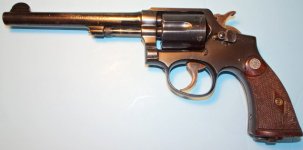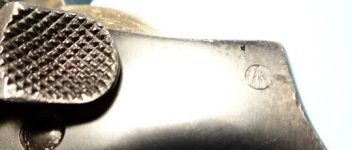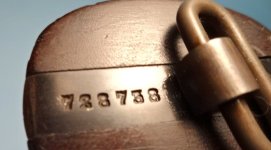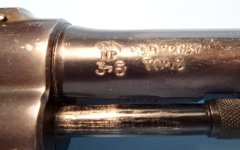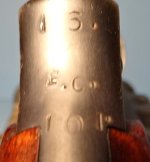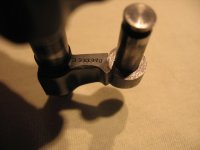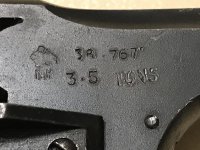grendelbean
US Veteran
I believe a recent acquisition is a really good example of the very early S&W British Service Revolver (BSR). All my limited information and partial knowledge is based on the research and writing of knowledgeable and experienced collectors. They have previously documented the history and development of these great historic firearms. Their writings have given me a lot of enjoyment. To them - Thank You.
This revolver is a commercial blue, six inch barrel M&P of the 4th change. It was likely produced at S&W Springfield between March and December 1940 on a direct British Purchasing Commission (BPC) contract. The research of others documents 112,854 revolvers sold directly to the BPC between June and December 1940. These guns were bright blue and were for the .38/200 British Service Cartridge. This caliber revolver began production by S&W around serial number 680,000 of the Fourth change. This was about March 1940 and was under a direct British contract for direct delivery to the U.K. and Commonwealth countries.
By October 1940 almost all the production capacity was taken up by manufacture of thee British Service Revolvers. Also in October 1940 the barrel length for the BSR was standardized at 5 inches.
These two checkpoints - beginning of sales to the U.K. in March and standardization of the 5" barrel in October - form a basis for my estimate the production period of this six inch barrel BSR. Hopefully, the data base or a future letter of authentication my further refine that estimate.
Six-inch barrel revolvers were distributed to Canada, the Union of South Africa and doubtless other areas as well. As this particular revolver has the Canadian marking on the frame and also British Proof Marks, it apparently went to Canada for service, then to Gr. Britain, probably after the War, for surplus sale. The revolver there received commercial London Proof House markings.
With the outbreak of World War II Canada elected to adopt the S&W M&P Model which would accommodate the standard British .38/200 cartridge. Over 118,000 of these revolvers were purchased from 1939 through 1943.
Configuration of the Canadian-issue arms was a double-action revolver with polished blue and checkered grips, though brushed-blue and wartime finishes were also widely used. Walnut grips were standard. Most common were 5" barrels, but 4", and 6" were also in service.
The .38/200 BSRs were called the K-200. 110,379 K-200s were sold to the British beginning with about serial number 680,000. This present BSR is less than 50,000 serial number later, confirming it is an early version.
Production under contracts between S&W and the British began in March 1940. When finally terminated by the British Purchasing Commission in March 1945 about 567,204 revolvers had been built for the British and Commonwealth forces (Gr. Britain, Australia, New Zealand, Canada, Union of South Africa).
Regarding this specific BSR (s/n 728738), it has standard S&W factory markings including "Reg.U.S. Pat. Off" visible on the upper curve of the hammer body. The gun has a nice commercial blue with very little wear. The very small age "dings" in the finish just about take a magnifying glass to see them.
The stocks are original and walnut, checkered with diamonds and silver monograms in the upper circles. The right-side stock is numbered to the gun. At some point someone has painted the stocks with varnish or some other clear finish, but otherwise they are in excellent condition.
The butt is marked with the serial number and a proof mark"P"
readable with the barrel to the right. The numbers of the serial number are of the smaller size and font-style of the period. The letter "B" is found on the grip frame under the right stock, with the letter "K" under the left stock.
The serial number 728738 is marked on the butt, the rear of the cylinder, on the barrel flat, and on the back side of the extractor star and on the side of the yoke arm visible through the chambers of the cylinder. The barrel flat on the bottom of the barrel also has the marking "O" to the left of the serial number.
Assembly numbers 63837 are on both the yoke and the yoke frame.
The Canadian mark, a Broad Arrow in a "C"is finely done and is on the rear point of the left side frame. At the top of the backstrap are post-factory stampings: "1 6 . over P. C. over 1 0 1." Thanks to knowledgeable forum members these markings stem from the revolvers service with the Canadian Provost Corps. It apparently served with No. 16 Provost Company and had a rack number of 101. There is an interesting history of the Provost Corps and it's Companies elsewhere on the internet.
Learning about this revolver, with it's interesting history, has been great fun. The added input from members who actually know about what they speak has been a enlightenment. I have re-read Pate Chapter 6 and have the best understanding of the British markings of military handguns than I have ever had. Thanks for all the help and information.
Pictures attached. Thanks.
This revolver is a commercial blue, six inch barrel M&P of the 4th change. It was likely produced at S&W Springfield between March and December 1940 on a direct British Purchasing Commission (BPC) contract. The research of others documents 112,854 revolvers sold directly to the BPC between June and December 1940. These guns were bright blue and were for the .38/200 British Service Cartridge. This caliber revolver began production by S&W around serial number 680,000 of the Fourth change. This was about March 1940 and was under a direct British contract for direct delivery to the U.K. and Commonwealth countries.
By October 1940 almost all the production capacity was taken up by manufacture of thee British Service Revolvers. Also in October 1940 the barrel length for the BSR was standardized at 5 inches.
These two checkpoints - beginning of sales to the U.K. in March and standardization of the 5" barrel in October - form a basis for my estimate the production period of this six inch barrel BSR. Hopefully, the data base or a future letter of authentication my further refine that estimate.
Six-inch barrel revolvers were distributed to Canada, the Union of South Africa and doubtless other areas as well. As this particular revolver has the Canadian marking on the frame and also British Proof Marks, it apparently went to Canada for service, then to Gr. Britain, probably after the War, for surplus sale. The revolver there received commercial London Proof House markings.
With the outbreak of World War II Canada elected to adopt the S&W M&P Model which would accommodate the standard British .38/200 cartridge. Over 118,000 of these revolvers were purchased from 1939 through 1943.
Configuration of the Canadian-issue arms was a double-action revolver with polished blue and checkered grips, though brushed-blue and wartime finishes were also widely used. Walnut grips were standard. Most common were 5" barrels, but 4", and 6" were also in service.
The .38/200 BSRs were called the K-200. 110,379 K-200s were sold to the British beginning with about serial number 680,000. This present BSR is less than 50,000 serial number later, confirming it is an early version.
Production under contracts between S&W and the British began in March 1940. When finally terminated by the British Purchasing Commission in March 1945 about 567,204 revolvers had been built for the British and Commonwealth forces (Gr. Britain, Australia, New Zealand, Canada, Union of South Africa).
Regarding this specific BSR (s/n 728738), it has standard S&W factory markings including "Reg.U.S. Pat. Off" visible on the upper curve of the hammer body. The gun has a nice commercial blue with very little wear. The very small age "dings" in the finish just about take a magnifying glass to see them.
The stocks are original and walnut, checkered with diamonds and silver monograms in the upper circles. The right-side stock is numbered to the gun. At some point someone has painted the stocks with varnish or some other clear finish, but otherwise they are in excellent condition.
The butt is marked with the serial number and a proof mark"P"
readable with the barrel to the right. The numbers of the serial number are of the smaller size and font-style of the period. The letter "B" is found on the grip frame under the right stock, with the letter "K" under the left stock.
The serial number 728738 is marked on the butt, the rear of the cylinder, on the barrel flat, and on the back side of the extractor star and on the side of the yoke arm visible through the chambers of the cylinder. The barrel flat on the bottom of the barrel also has the marking "O" to the left of the serial number.
Assembly numbers 63837 are on both the yoke and the yoke frame.
The Canadian mark, a Broad Arrow in a "C"is finely done and is on the rear point of the left side frame. At the top of the backstrap are post-factory stampings: "1 6 . over P. C. over 1 0 1." Thanks to knowledgeable forum members these markings stem from the revolvers service with the Canadian Provost Corps. It apparently served with No. 16 Provost Company and had a rack number of 101. There is an interesting history of the Provost Corps and it's Companies elsewhere on the internet.
Learning about this revolver, with it's interesting history, has been great fun. The added input from members who actually know about what they speak has been a enlightenment. I have re-read Pate Chapter 6 and have the best understanding of the British markings of military handguns than I have ever had. Thanks for all the help and information.
Pictures attached. Thanks.
Attachments
Last edited:

